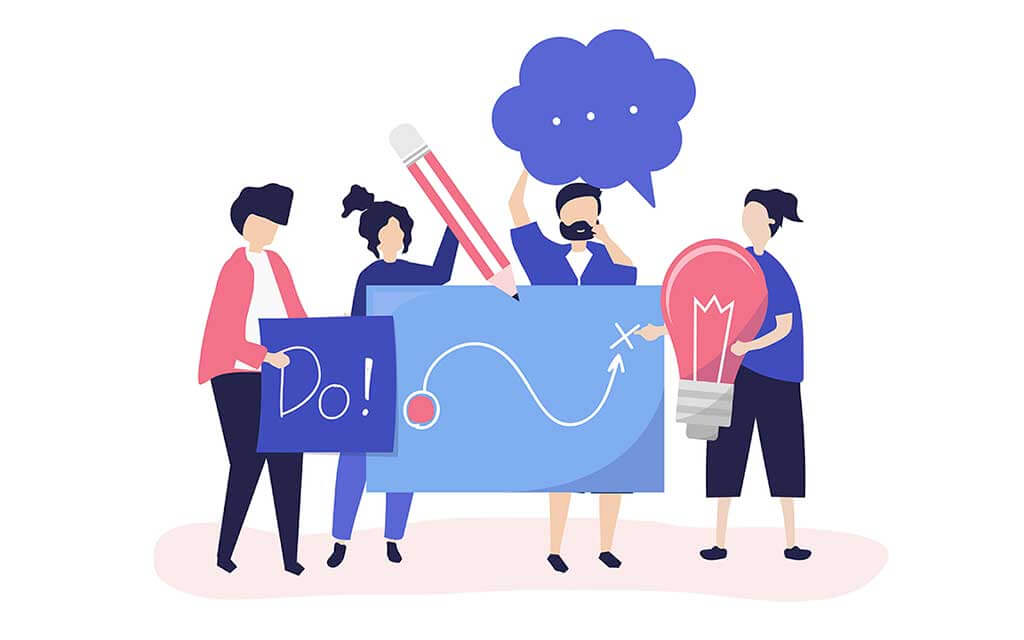Table of Contents
ToggleEstablish Team Goals Or Objectives
Setting clear and quantifiable goals is the cornerstone of effective team management. For example, a sales team might aim to increase revenue by 15% quarter over quarter, using specific metrics such as the number of closed deals or customer retention rates to measure success. These objectives should align with the overall company strategy and be communicated transparently to ensure every team member understands their individual and collective targets.
Develop Effective Communication Strategies
Open and consistent communication fosters a collaborative environment. Implement regular weekly meetings and use tools like Slack for daily updates. A real-world example could be a development team adopting Agile practices, where daily stand-ups and sprint reviews keep everyone informed about project progress and immediately address any issues.
Foster Team Collaboration and Cohesion
Promoting teamwork can significantly enhance productivity. For instance, creating cross-functional teams for a project can lead to innovative solutions and faster problem-solving. Utilize team-building activities that focus on strengthening relationships and understanding roles, like workshops or off-site retreats.
Implement Performance Metrics and Feedback Systems
Regular feedback and clear metrics are vital for growth. Use KPIs (Key Performance Indicators) like project completion rate or customer satisfaction to gauge performance. Incorporate 360-degree feedback to provide a well-rounded view of team dynamics and individual contributions, which can highlight areas for improvement and celebrate successes.
Encourage Professional Development and Continuous Learning
Investing in your team’s growth not only boosts morale but also keeps your team competitive. Offer training sessions, professional courses, and attendance at industry conferences. For example, a tech company might provide yearly allowances for certifications or new software training, directly contributing to the team’s efficiency and adaptability.
Manage Conflicts and Challenge Resolution
Effective conflict resolution maintains a healthy work environment. When issues arise, address them promptly through mediation sessions or conflict resolution workshops. An example scenario could involve a disagreement between team members over resource allocation, which could be resolved through a structured discussion facilitated by a manager.

Supervise, Train Or Advise Team Members
Direct supervision and personalized training plans are key to enhancing team performance. A practical example is a manager at a marketing firm who schedules bi-weekly check-ins with team members to discuss ongoing projects and adjust strategies as needed. This approach ensures that each member receives attention to detail in their tasks and guidance on how to improve.
Utilize Targeted Training Programs
Targeted training programs tailored to specific skills gaps can dramatically improve team efficiency. For instance, a tech company may identify a need for better software testing skills and could set up a series of workshops run by external experts. These sessions could be reinforced by online modules that team members complete at their pace.
Develop a Mentorship Culture
Establishing a mentorship program within the team can lead to significant knowledge sharing and support. Pairing junior staff with experienced colleagues can help transfer critical skills, enhance understanding, and improve morale. This system also prepares junior members for future leadership roles, making it a sustainable strategy.
Implement Continuous Feedback Mechanisms
Continuous feedback is essential for ongoing development. Tools like real-time feedback apps or monthly performance reviews can provide immediate insights into team members’ work, allowing for quicker adjustments and learning. For example, a customer service team could use customer satisfaction scores as immediate feedback for personal development.
Foster a Learning Environment
Encourage a culture of continuous learning to keep your team updated and adaptable. Regular training sessions, access to courses, and time allocated for learning new technologies or methods can keep your team at the forefront of industry developments. An example could be a finance team learning new data analytics software, which could lead to more insightful reports and decision-making.
Mediate Interpersonal Conflicts
Effective conflict mediation requires a structured approach to ensure conflicts are resolved fairly and swiftly, enhancing team cohesion. For example, a project manager in a software development company might encounter a conflict between two developers over code implementation strategies. By setting up a mediation meeting that focuses on collaborative problem-solving, the manager can help them reach a consensus that respects both viewpoints.
Establish Clear Communication Channels
Open and direct communication is fundamental in managing conflicts. Introduce communication protocols that encourage openness and respect. This could include setting ground rules for discussions, such as no interruptions, and using “I” statements to express personal viewpoints without assigning blame.
Train Managers in Conflict Resolution
Training managers to handle disputes effectively can prevent many issues from escalating. Provide them with training on conflict resolution techniques, such as active listening and negotiation skills. This training can be augmented with role-playing exercises that simulate real-life scenarios, preparing them to handle conflicts adeptly.
Foster an Atmosphere of Respect and Inclusion
Cultivating a respectful workplace can significantly reduce the frequency and intensity of conflicts. Implement policies that promote diversity, equity, and inclusion. Regular team-building exercises can strengthen bonds and build mutual respect, which are critical in preemptive conflict management.
Utilize Neutral Third Parties When Necessary
Bringing in a neutral third party can be invaluable in resolving more severe conflicts. This could be an HR representative or an external mediator who can provide an unbiased perspective and facilitate a fair resolution process. For instance, when two department heads disagree on resource allocation, a neutral mediator can help them find a solution that aligns with the organization’s best interests.
Motivate And Inspire Team Members
Creating a motivating work environment is essential for maximizing productivity and satisfaction among team members. For example, a tech company could implement a recognition program where achievements are publicly acknowledged, boosting morale and inspiring others to excel. Regular inspirational talks from leaders or industry experts can also energize the team and reinforce a positive workplace culture.
Set Clear and Achievable Goals
Setting clear, achievable goals provides team members with a sense of direction and accomplishment. For instance, a sales team could be motivated by a tiered goal system where reaching each level brings small rewards, culminating in a significant year-end bonus for achieving the highest targets.
Provide Regular Recognition and Rewards
Frequent recognition and tangible rewards are powerful motivators. These can range from simple thank-you notes for daily achievements to more substantial rewards like bonuses or promotions for major milestones. This approach not only fosters a positive environment but also shows that the organization values hard work and dedication.
Encourage Autonomy and Ownership
Encouraging autonomy in task management can significantly boost a team member’s motivation and creativity. Allowing team members to own their projects or make decisions about how to achieve their goals empowers them and can lead to innovative solutions and greater job satisfaction.
Support Personal and Professional Growth
Investing in the personal and professional growth of team members is a key motivator. Offer opportunities for further education, training seminars, and attendance at industry conferences. An example includes a company sponsoring an employee’s participation in a professional development program, which not only enhances their skills but also demonstrates the company’s commitment to their career growth.
Help Employees Grow
Implementing a structured employee growth plan is crucial in helping individuals achieve their career goals while contributing to the company’s objectives. For instance, an engineering firm could use a clear progression roadmap that outlines the competencies and milestones required to move from junior to senior roles, providing regular assessments and feedback sessions to guide development.
Offer Tailored Training Programs
Tailored training programs specific to the skills each employee needs to develop can dramatically enhance their effectiveness and satisfaction. For example, a marketing agency might offer digital marketing courses to its staff, focusing on the latest tools and strategies in the industry, thereby keeping their skills sharp and relevant.
Create Opportunities for Career Advancement
Creating clear paths for career advancement motivates employees by showing them how they can progress within the organization. This could involve establishing mentorship programs where seasoned employees guide newer ones, providing insights and advice based on their own experiences.
Foster a Culture of Continuous Learning
Promoting a culture of continuous learning can encourage employees to pursue ongoing professional development. This might include access to a learning management system with a variety of courses available, encouraging employees to learn at their own pace and according to their interests and career needs.

Support Work-Life Balance
Supporting work-life balance is key to employee growth and retention. Flexible working arrangements, such as telecommuting or adjustable work hours, can help employees manage their personal and professional lives more effectively, which can lead to increased productivity and job satisfaction.
Remote Team Management
Effective management of remote teams requires specific strategies to ensure communication, productivity, and engagement are maintained across different locations and time zones. For example, a software development company with a remote team might use a combination of synchronous (real-time) and asynchronous tools to facilitate collaboration and ensure all team members can contribute regardless of their physical location.
Utilize the Right Communication Tools
Selecting the right communication tools is fundamental in remote team management. Use video conferencing tools like Zoom for weekly team meetings and daily stand-ups, and platforms like Slack or Microsoft Teams for continuous, informal communication and updates. This ensures that everyone stays connected and informed about the team’s progress and any issues that may arise.
Set Clear Expectations and Guidelines
Setting clear expectations and guidelines helps maintain productivity and focus. Specify work hours, availability, and deadlines for projects. For instance, you might require team members to be available online from 10 AM to 3 PM in their respective time zones to overlap for collaborative work and meetings.
Foster a Strong Team Culture
Creating a strong, inclusive team culture virtually is crucial. Organize regular virtual team-building activities, such as online games or coffee breaks, where team members can interact and bond beyond work topics. This helps in building trust and camaraderie among remote workers.
Implement Regular Feedback and Check-ins
Regular feedback and check-ins are essential to understand the challenges faced by remote employees and to provide them with support. Implement a bi-weekly one-on-one meeting schedule where managers can speak with team members individually to discuss performance, well-being, and any support they may need.
Encourage and Support Flexibility
Encouraging flexibility in working hours and methods can lead to higher job satisfaction and productivity among remote workers. Allow team members to adjust their schedules as needed to fit their personal responsibilities and peak productivity times, as long as they meet their objectives and maintain team collaboration.



